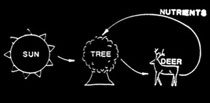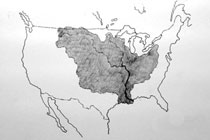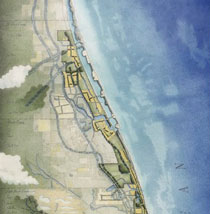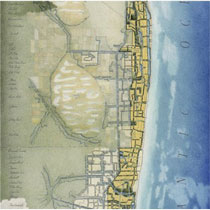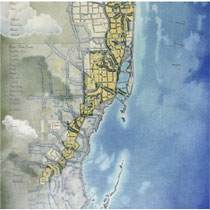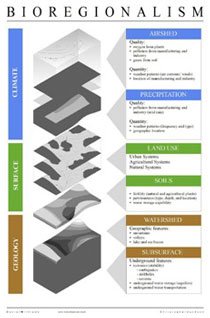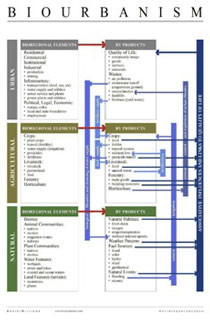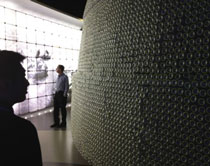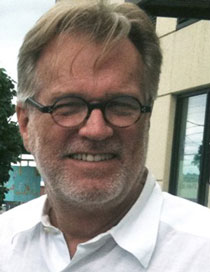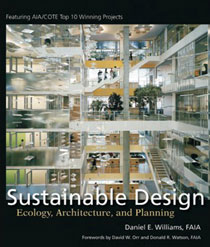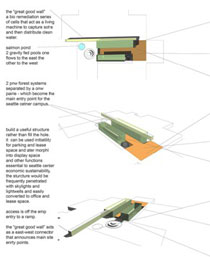
USA:
Intervista con Daniel E. Williams*. Cesare Corfone |
 |
C.C. In your last book, “Sustainable Design – Ecology, Architecture, and Planning”, you often refer to ecological processes as sustainable design tools. How can the ecological model guide architects and planners towards innovation sustainable-solutions?
D.E.W. The ecological model illustrates that ecology is a spatial web of connections where energy, materials and information are linked between multiple organisms and places. It shows the processes that drive the ecological system under study, as well as the cycles associated with the flow of energy and materials essential to its existence. The success of the system is due, in part, to the connectivity between parts. The model devised by Dr. Howard T. Odum illustrates the relationship between flows of energy and materials between system components and between producers and consumers. Deers are born in forests where they eat the lower plants then defecate which nourishes the plants and the trees that provide them food and habitat so that they have a place to be born and eat and so on... simple! The ecological model is a powerful tool as it illustrates that the challenge of designing sustainable patterns is simply to design the linkages and the structures that will recreate and reinforce the natural system cycles.
An example of a design and planning challenge to be revisited is: California uses 20% of its electricity to distribute water, but gravity does it for free - therefore over the next 100 years start by redesigning urban and agricultural patterns and urban locations in California so that water is distributed by gravity.
C.C. The ecological model will be useful to update our infrastructure: in which way can these ecological infrastructures help the sustainable redevelopment of U.S. cities and regions?
D.E.W. Infrastructures are the below and above grade structures that move people and materials and also provide services like safe drinking water and sewage removal and clean up.
I recently designed some kind of “urban ecology infrastructure” for Seattle, Washington, that captures and cleans up stormwater that gravity flows from the upland neighborhoods. This biofiltered water is then introduced to new streams with the intent of creating salmon habitat and spawning pools. These streams flow through a community-planted forest that in 50 years will be, in the center of the city of Seattle, a native forest. “The long wall” is an educational intervention with classrooms and living machines to be used by the public school system to introduce the concept of urban ecology, and biourbanism - recreating a city that works like biology.
Another example: many neighborhoods can exist in floodplains and flood prone areas because there is a huge infrastructure of pipes and pumps to remove floodwater. In virtually all places where this occurs they do considerable service to the community but always fail.
The Mississippi River Watershed representing 40% of the land area in the 48 states was engineered for navigation and flood protection. This work has been going on for over 100 years, yet in May of 2011 the banks of the Mississippi going thru New Orleans were close to failing and would have if the levies were not removed allowing the land they were designed to protect - flood again. This is important not so much because of the huge expense to get an extremely powerful and unrelenting force to "not be what it is", but because the issue most pressing the region presently and for the next millennia is drought - which is already in some areas the worst drought in 400 years. What I am presently working on is "re-plumbing the Mississippi River Watershed" - so that it works with the power of the River.
Re-plumbing in this case means redesigning the anthropic systems to work with the natural flows of the river and watershed rather than forcing it to do something “it does not want to”. While the system still provides for flood protection it recharges ground water storages - mitigating drought impacts - and rebuilds the soil for agriculture – simple.
C.C. Environmental sustainability continues to be part of your post-disaster planning conception, as it was for yours southeast Florida plans. What did sustainability meant in the “Watershed Interactive Network Plan” in the south of Miami Metropolitan Area?
D.E.W. Adversity to opportunity is a mantra for post-hazard rebuilding. Anytime there is a major change in an existing urban or regional pattern - due to natural or human created disasters - it provides an opportunity not only to build better but build in more sustainable locations and in a manner that reduces the carbon footprint while integrating natural system functions into the new pattern.
In the “South Dade Watershed Project” (1994) we created a plan that connected a sustainable potable water supply with agricultural health, jobs, transportation and natural system protection in the Everglades National Park and the estuaries along the bay. This plan was called the WIN Plan (Watershed Interactive Network) which designed and planned future urban and regional patterns based on the carrying-capacity of local resources and the long term challenges of climate change and sea level rising.
The watershed design approach recreates many successful connections: storing water within hydric green and blueways will increase water supplies for future use and is the most effective way of increasing potable water storage; protection of natural-system functioning within regional and urban greenways increases the value of properties and territories; ecosystem management and watershed planning simultaneously address the complex issues of urban quality of life.
C.C. Urban and environmental regeneration of southeast coastal zone of Florida is a crucial point in your research route: what was the basis for your design and planning choices in this area?
D.E.W. This area too has a similar heavy-hand when it comes to flood removal. South Florida was/is a swamp and the entire region including the Everglades National Park, the reef systems and the health of the bay and estuaries was due to rainfall and slow movement of massive amounts of rainfall into the bay. The historic thinking was to drain the swamp and create more arable land with areas for settlements - at the time, a logical conclusion. But when we analyzed the existing conditions we found that the drainage minimized the storage of drinkable water and saltwater was contaminating the remaining freshwater underground storages.
Climate change and sea level rise has added a more challenging aspect to this - the coastal land is being inundated by seawater. The climate-change engine is too large and unpredictable and we know that walls and dams and barriers will have no effect so south Florida will become a series of islands in the next 100 years or so - the problem has not been responded too because it has never been done before. The bioregionalism, that I propose, researches and understands the system larger than the project scale and looks to solutions that will last 1000 years.
C.C. I see that your design process starts with the gathering of long-term and large-scale information on natural patterns and conditions, but what do you mean by “bioregionalism” and “biourbanism”?
D.E.W. Combining biology and community creates a human ecology and a biological urbanism, that is, a biourbanism. Biourbanism and bioregionalism refer to the opportunities in urban and regional design to recreate linkages to biological processes. Incorporating the natural-system sciences of the region into the urban community pattern, biourbanism connects urban, agricultural, and natural system functioning. Biourbanism designs the connections to make use of free work of nature that is incorporated in urban systems by using natural processes rather than technology for water storage and cleaning, for microclimate control, and for resource use, reuse, and recycling.
An example is capturing stormwater and cleaning it up with biological uptake so that the water becomes part of the new supply of potable water. In this case the biological function is doing a service for the community that typically would be done with built infrastructure that is paid for with taxes. By using the free natural system function of biological uptake we are creating an additional supply of water while cleaning up pollution and toxins.
C.C. Water seems to be your key design element at all scales: I often wonder whether the architects could proactively protect water through their design.
D.E.W. In the global potable water discussion I usually make the point that "there is good news and bad news... the good news is by 2020 we will be drinking our own sewage, the bad news is - there will not be enough”.
The general principle is that a site, neighborhood, town, city and region must supply its water from the watercrop that lands within its boundaries. This is the “principle of carrying capacity” and should be applied at all scale of design intervention.
We have for centuries had abundant water supplies but as of mid-way through the 1900's the amount needed was less that the supply in virtually all-local situations. Because water was in short supply technology was created to (much like oil) bring it up from ground water storages. This was a simple and inexpensive solution until the water rate-of-use was greater than the recharge rate. Once the storage and recharge was less than the renewal rate the system had surpassed its carrying capacity. No matter what technology is thrown at the water-supply problem, when it comes to water there is a finite amount. If a community is using more than is being replaced it cannot survive. The solution to this is the challenge - at all scales - to design the project to capture, store, and distribute the energy and resources - especially water - needed to have it function for its intended purpose.
* Daniel E. Williams, FAIA, APA
dwa-design | architecture, urban and regional design, Seattle, Washington, USA.
www.dwa-design.com
Daniel E. Williams is a practicing architect and planner and has led pre and post disaster planning and rebuilding efforts for over 30 years. His work in Florida after Hurricane Andrew (1992) earned the 1999 and 2000 National AIA Honor Award for Urban and Regional Design - is a model for long-term rebuilding efforts that incorporate solutions to economic, ecological, flooding and drought challenges. Dan received his Fellowship in the American Institute of Architects for his work with communities designing resilient urban and regional patterns after natural disasters and is an internationally recognized expert in sustainable architecture and urban and regional design.
In 2007 he wrote “Sustainable Design: Ecology, Architecture and Planning” which Planetizen named as one of the top 5 books in sustainable planning and design. He is a member of the experts team for the Clinton Climate + Initiative, advising on projects in Toronto and London. In 2003 he was national chair for the AIA's Committee on the Environment, COTE, and in 2006 he chaired the AIA’s Sustainability Task Group and was appointed to the national advisory council for United States Environmental Protection Agency - EPA/NACEPT. In 2011 he chaired the national jury for AIA/RUD awards. In 2010 he participated in the development of the Council of Mayor’s resolution that will reduce carbon emissions by 50%; edited and co-wrote the Site & Land Use section of the IgCC - International Green Construction Codes; presented Watershed Planning Initiatives at the Center for Neighborhood Technologies in Chicago; wrote and chaired the AIA/EPA grant Water + Design: Conference; and co-wrote the Barcelona Declaration on Sustainability.
Dan has worked with dozens of communities around the country, creating master plans with the residents – specifically to assist in the rebuilding of towns and cities after natural disasters and the associated impacts from climate change - he presented this work to the FEMA "Project Impact" workshop at Wingspread. In 2004 he helped create the AIA Livable Communities program and directed the first SDAT - Sustainable Design Assessment Team for the AIA. Dan chaired the Task Force on the Environment and Energy for the Congress for the New Urbanism from 1996 – 2000 and won the first passive design award in Architecture from NASA in 1980. As a planner in San Francisco he worked on the BART system planning and the post-disaster planning vision for the Embarcadero removal. As a VISTA volunteer he developed a self-help housing construction method that enabled families to build their own homes. As former Director of the Education and Research Center for the University of Florida, College of Design and Construction he led projects in Miami's Little Haiti community and Belle Glade Community in central Florida. In 1993 he was Research Professor at the Center for Urban and Community Design at the University of Miami, College of Architecture where he led planning and rebuilding efforts after Hurricane Andrew in 1992.
Dan was named Eminent Scholar and Distinguished Alumni in 2000 at the University of Florida and is teaching the sustainable design course for the Masters in Sustainable Design in Singapore. He is presently working on a book titled “designED: An Ecological Approach to Regional and Urban Sustainability”.
 |
EWT/ EcoWebTown |
